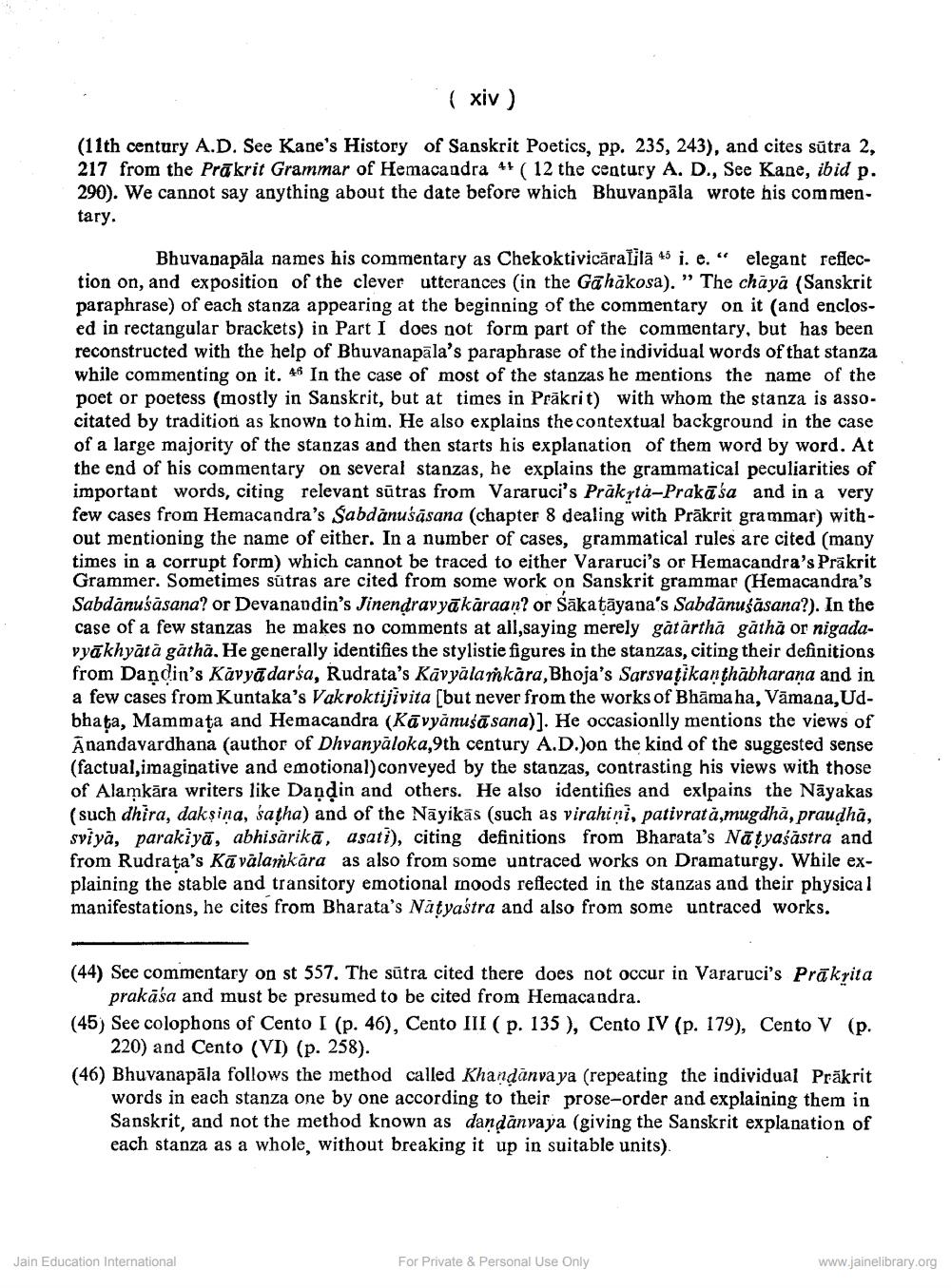________________
( xiv)
(11th century A.D. See Kane's History of Sanskrit Poetics, pp. 235, 243), and cites sūtra 2, 217 from the Prakrit Grammar of Hemacandra (12 the century A. D., See Kane, ibid p. 290). We cannot say anything about the date before which Bhuvanpäla wrote his commen
tary.
Bhuvanapala names his commentary as Chekoktivicaralila" i. e." elegant reflection on, and exposition of the clever utterances (in the Gahakosa)." The chaya (Sanskrit paraphrase) of each stanza appearing at the beginning of the commentary on it (and enclosed in rectangular brackets) in Part I does not form part of the commentary, but has been reconstructed with the help of Bhuvanapala's paraphrase of the individual words of that stanza while commenting on it. 46 In the case of most of the stanzas he mentions the name of the poet or poetess (mostly in Sanskrit, but at times in Prakrit) with whom the stanza is associtated by tradition as known to him. He also explains the contextual background in the case of a large majority of the stanzas and then starts his explanation of them word by word. At the end of his commentary on several stanzas, he explains the grammatical peculiarities of important words, citing relevant sūtras from Vararuci's Prakyta-Prakasa and in a very few cases from Hemacandra's Sabdanusāsana (chapter 8 dealing with Prakrit grammar) without mentioning the name of either. In a number of cases, grammatical rules are cited (many times in a corrupt form) which cannot be traced to either Vararuci's or Hemacandra's Prakrit Grammer. Sometimes sutras are cited from some work on Sanskrit grammar (Hemacandra's Sabdanusāsana? or Devanandin's Jinendravyakaraan? or Sakaṭayana's Sabdanugasana?). In the case of a few stanzas he makes no comments at all,saying merely gàtärtha gàthà or nigadavyakhyāta gatha. He generally identifies the stylistie figures in the stanzas, citing their definitions. from Dandin's Kavyadarsa, Rudrata's Kavyalahkara, Bhoja's Sarsvațikaṇṭhābharaṇa and in a few cases from Kuntaka's Vakroktijlvita [but never from the works of Bhama ha, Vamana,Udbhața, Mammața and Hemacandra (Kāvyānusāsana)]. He occasionlly mentions the views of Anandavardhana (author of Dhvanyaloka,9th century A.D.)on the kind of the suggested sense (factual,imaginative and emotional) conveyed by the stanzas, contrasting his views with those of Alamkara writers like Daṇḍin and others. He also identifies and exlpains the Nayakas (such dhira, daksina, satha) and of the Nayikās (such as virahini, pativrata,mugdha, prauḍhā, sviya, parakiya, abhisarikā, asati), citing definitions from Bharata's Natyasastra and from Rudrata's Kāvālamkāra as also from some untraced works on Dramaturgy. While explaining the stable and transitory emotional moods reflected in the stanzas and their physical manifestations, he cites from Bharata's Natyastra and also from some untraced works.
(44) See commentary on st 557. The sutra cited there does not occur in Vararuci's Prakrita prakāśa and must be presumed to be cited from Hemacandra.
(45) See colophons of Cento I (p. 46), Cento III (p. 135), Cento IV (p. 179), Cento V (p. 220) and Cento (VI) (p. 258).
(46) Bhuvanapala follows the method called Khandanvaya (repeating the individual Prakrit words in each stanza one by one according to their prose-order and explaining them in Sanskrit, and not the method known as dandanvaya (giving the Sanskrit explanation of cach stanza as a whole, without breaking it up in suitable units).
Jain Education International
For Private & Personal Use Only
www.jainelibrary.org




